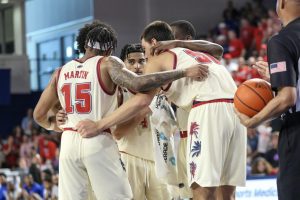Patch, a large female burrowing owl, perches on a low railing and watches baseball practice during overcast afternoons. Her three babies tend to stay close to the mouth of their nest in case trouble comes their way, which Patch is all too aware of.
The mother owl lost her right eye at some point in the past few years. Her nest, the only approachable one on campus, is located near baseball fields by the Oxley Center. The close proximity to people has caused some complication in her life, such as coconuts and trash lodged in her burrow, but Patch has managed to continue breeding through the hardships.
The Audubon Society declared FAU a burrowing owl sanctuary on April 23, 1971. Around the same time the Florida Fish and Wildlife Conservation Commission declared the Owls a “Species of Special Concern” due to dwindling populations throughout the state.
The owls originally moved to FAU’s campus because of heavy construction in the area. FAU offered wide-open areas for the owl to hunt. Burrowing owls prefer land that has few, if any, trees for their many predators to hide in.
The owls have round heads, lack ear tufts and are sandy in color. Their eyebrows are white, their eyes are yellow and their legs are long for a bird of that size. Females, while usually darker than the male, tend to be around the same size, instead of larger as is found in most other species. They are also diurnal, hunting insects by day, and mammals by night.
The most interesting fact about our little mascots is that they decorate their nest with mammal dung, which not only attracts insects, but impresses their mates as well, according to a September 2004 article from National Geographic.
According to Alumnus Annabelle McKie’s master thesis, which was centered on the Burrowing Owl population, in 1971 there were over 150 owls on campus – today around 20 remain. Many factors contributed to the steep and sudden decline of the owl population such as construction and human interaction.
In 2004, five pairs of breeding adults were active on campus with each pair mating yearly. The babies, or chicks, will sometimes leave the area and come back years later to raise their own young.
While federal law protects the burrowing owls from harm because of their “Special Concern” status, they are still in danger from people and other predators. McKie told the UP in 2004 that unknown people killed owls that lived near Timucua Hall by throwing beer bottles at them. For that reason, officials are hesitant to mention the location of other burrows.
For decades the small ground dwelling owl has been FAU’s mascot. At one point the baseball team chose to become the Blue Wave, instead of using the owl as their mascot, but after a widespread branding process undergone by FAU last semester, all teams and agencies at FAU adopted the feisty birds as their symbol. The logo, stitched onto hats and t-shirts all over campus, appears not how the owl is seen in the wild by people, but from a lizard or rat’s perspective – poised to kill.











